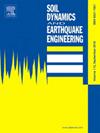Simplified prediction of settlements of shallow foundations caused by earthquake-induced excess pore water pressures
IF 4.2
2区 工程技术
Q1 ENGINEERING, GEOLOGICAL
引用次数: 0
Abstract
Seismic actions are usually considered for their inertial effects on the built environment. However, additional effects may be caused by the volumetric-distortional coupling of soil behaviour: the fast cyclic shaking on saturated soils caused by earthquakes generates temporary undrained or quasi-undrained conditions and subsequent pore pressure variations that, if positive, reduce the effective stresses, eventually leading loose granular soils to liquefaction. Whatever the amount of seismically induced pore pressure build up, buildings on shallow foundations suffer settlements and tilts that may be extremely large when soils approach liquefaction, as demonstrated by several recent case histories. The paper proposes an equivalent elastic approach in effective stresses to predict the co-seismic (undrained) component of the seismically induced settlement of shallow foundations, which usually is the most relevant one, by considering the decrease of soil stiffness during the seismic event. The total settlement can be then estimated by adding the post-seismic (drained) component, also evaluated in this paper via a quite simple approach. Even though the equivalent elastic model is stretched into a highly non-linear soil behaviour range, especially when the soil is approaching liquefaction, the model considers the relevant capacity and demand factors and proved effective in simulating some centrifuge tests published in the literature. In the paper, the simplifying assumptions of the approach are clearly indicated, and their relevance discussed. It is argued that notwithstanding some limitations the model is physically based and therefore it allows for understanding and checking the relative relevance of all the parameters related to soil, foundation, and seismic action. Thus, it is a tool of possible interest in the design of shallow foundations in liquefaction-prone seismic areas.
地震引起的过大孔隙水压力导致浅层地基沉降的简化预测
地震作用通常被认为是对建筑环境的惯性效应。然而,土体特性的体积-扭曲耦合可能会引起额外的影响:地震引起的饱和土上的快速循环振动会产生暂时的不排水或准不排水条件,以及随后的孔隙压力变化,如果这种变化是积极的,则会降低有效应力,最终导致松散的颗粒土液化。无论地震引起的孔隙压力积累了多少,当土壤接近液化时,浅基础上的建筑物都会遭受沉降和倾斜,这些沉降和倾斜可能会非常大,正如最近的几个历史案例所证明的那样。本文提出了一种有效应力等效弹性方法,通过考虑地震过程中土体刚度的降低,来预测浅层基础地震诱发沉降的同震(不排水)分量,这通常是最相关的。然后可以通过加入震后(排水)分量来估计总沉降,本文也通过一种相当简单的方法进行了评估。尽管等效弹性模型被拉伸到一个高度非线性的土壤行为范围,特别是当土壤接近液化时,该模型考虑了相关的容量和需求因素,并在模拟一些文献中发表的离心机试验中被证明是有效的。本文明确指出了该方法的简化假设,并讨论了它们的相关性。有人认为,尽管存在一些局限性,但该模型是基于物理的,因此它允许理解和检查与土壤、基础和地震作用相关的所有参数的相对相关性。因此,在液化易发地震地区的浅基础设计中,它是一个可能感兴趣的工具。
本文章由计算机程序翻译,如有差异,请以英文原文为准。
求助全文
约1分钟内获得全文
求助全文
来源期刊

Soil Dynamics and Earthquake Engineering
工程技术-地球科学综合
CiteScore
7.50
自引率
15.00%
发文量
446
审稿时长
8 months
期刊介绍:
The journal aims to encourage and enhance the role of mechanics and other disciplines as they relate to earthquake engineering by providing opportunities for the publication of the work of applied mathematicians, engineers and other applied scientists involved in solving problems closely related to the field of earthquake engineering and geotechnical earthquake engineering.
Emphasis is placed on new concepts and techniques, but case histories will also be published if they enhance the presentation and understanding of new technical concepts.
 求助内容:
求助内容: 应助结果提醒方式:
应助结果提醒方式:


